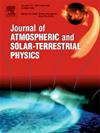Total ozone content in southeastern South America: A statistical analysis of 45 years of satellite data
IF 1.8
4区 地球科学
Q3 GEOCHEMISTRY & GEOPHYSICS
Journal of Atmospheric and Solar-Terrestrial Physics
Pub Date : 2025-02-27
DOI:10.1016/j.jastp.2025.106468
引用次数: 0
Abstract
This study investigates the Total Ozone Content (TOC) over Southeastern South America (SESA) using more than 45 years of satellite-derived data and ground-based Dobson spectrophotometer measurements over three sites. Satellite datasets from several missions were validated against ground-based Dobson observations, showing strong agreement with correlation coefficients exceeding 0.94 and biases below 2%. MERRA-2 monthly reanalysis data, also validated in this study, was used to complement satellite datasets for gap-filling. The analysis identified three distinct periods in ozone trends: a depletion phase (1979–1993) consistent with pre-Montreal Protocol conditions, a recovery phase (1994–2003) marked by positive trends, and a stabilization phase (2004–2023) with weak, less significant positive trends. Seasonal cycles during the stabilization period were obtained, showing lower ozone levels from January to May (around 265 DU), peaking in August to October (305 DU), with a consistent latitudinal gradient characterized by lower values at northern sites. A simple and accurate parametrization of the annual cycle was also derived at daily level, enabling daily ozone estimates and as a reference for anomaly detection. These findings contribute to a deeper understanding of ozone variability in the region, supporting global monitoring efforts and offering a foundation for evaluating the impacts of ozone dynamics on regional climate.
求助全文
约1分钟内获得全文
求助全文
来源期刊

Journal of Atmospheric and Solar-Terrestrial Physics
地学-地球化学与地球物理
CiteScore
4.10
自引率
5.30%
发文量
95
审稿时长
6 months
期刊介绍:
The Journal of Atmospheric and Solar-Terrestrial Physics (JASTP) is an international journal concerned with the inter-disciplinary science of the Earth''s atmospheric and space environment, especially the highly varied and highly variable physical phenomena that occur in this natural laboratory and the processes that couple them.
The journal covers the physical processes operating in the troposphere, stratosphere, mesosphere, thermosphere, ionosphere, magnetosphere, the Sun, interplanetary medium, and heliosphere. Phenomena occurring in other "spheres", solar influences on climate, and supporting laboratory measurements are also considered. The journal deals especially with the coupling between the different regions.
Solar flares, coronal mass ejections, and other energetic events on the Sun create interesting and important perturbations in the near-Earth space environment. The physics of such "space weather" is central to the Journal of Atmospheric and Solar-Terrestrial Physics and the journal welcomes papers that lead in the direction of a predictive understanding of the coupled system. Regarding the upper atmosphere, the subjects of aeronomy, geomagnetism and geoelectricity, auroral phenomena, radio wave propagation, and plasma instabilities, are examples within the broad field of solar-terrestrial physics which emphasise the energy exchange between the solar wind, the magnetospheric and ionospheric plasmas, and the neutral gas. In the lower atmosphere, topics covered range from mesoscale to global scale dynamics, to atmospheric electricity, lightning and its effects, and to anthropogenic changes.
 求助内容:
求助内容: 应助结果提醒方式:
应助结果提醒方式:


